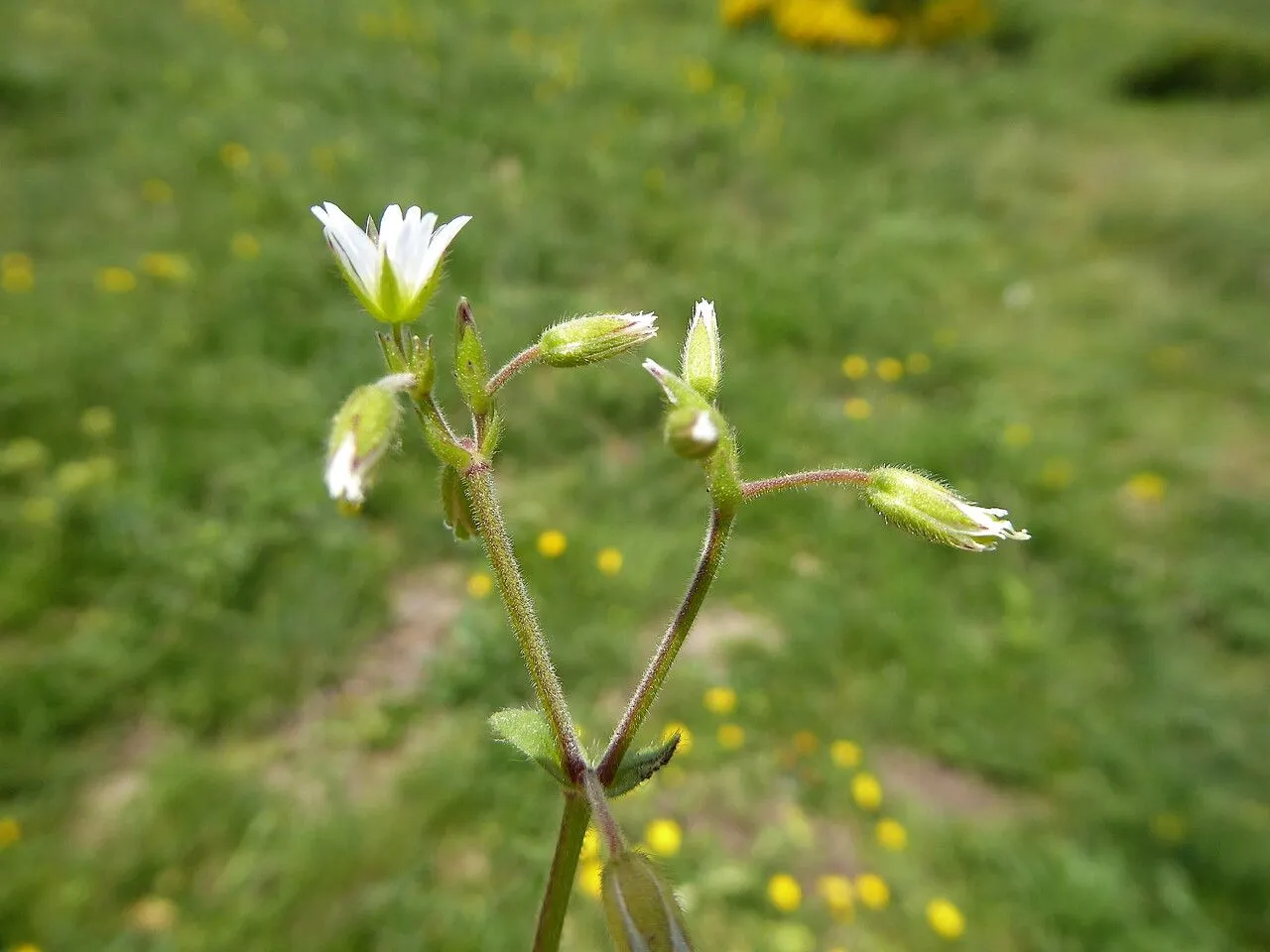
Author: Curtis
Bibliography: Fl. Londin. 4: t. 30 (1794)
Year: 1794
Status: accepted
Rank: species
Genus: Cerastium
Vegetable: Unknown
Observations: Europe to C. Asia, N. Africa
The European chickweed, scientifically known as Cerastium pumilum, is a captivating and hardy species belonging to the Caryophyllaceae family. Originally described by Curtis in 1794 in “Fl. Londin. 4: t. 30”, this petite yet robust plant is noted for its widespread adaptability and presence across a variety of landscapes.
In its natural habitat, European chickweed flourishes in diverse regions ranging from Europe to Central Asia and North Africa. The plant is well-suited to a range of climatic conditions thanks to its resilient nature. Renowned for its delicate appearance, Cerastium pumilum typically features slender, branching stems covered with fine hairs, adding to its charming, almost ethereal look. The leaves are small, oval-shaped, and often display a soft, grey-green hue that complements the plant’s understated aesthetic.
One of the prominent features of European chickweed is its clusters of tiny, star-like white flowers. These blossoms often grow in dense, leafy clusters, adding a splash of brightness to the greenery. Each flower is characterized by five deeply notched petals, making it instantly recognizable to botany enthusiasts and nature lovers alike.
Cerastium pumilum typically thrives in well-drained soils and is frequently found in a variety of settings, such as grasslands, open woods, and rocky areas. It plays a significant role in the ecosystem by providing habitat and food for various insects and other wildlife.
Despite its fragile appearance, European chickweed is a hardy and enduring plant that continues to expand its reach across its native territories. Its ability to adapt and flourish in varying conditions speaks to its evolutionary success and ecological importance.
Deu: dunkles hornkraut, niedriges hornkraut
Eng: european chickweed, dwarf mouse-ear, dwarf mouse-ear chickweed, curtis’ mouse-ear chickweed, curtis’s mouse-ear, european mouse-ear chickweed, dwarf chickweed, small chickweed, sticky mouse-ear chickweed
Dan: liden hønsetarm
Fra: céraiste nain
Nld: steenhoornbloem
Swe: alvararv, kalkarv
Nob: klisterarve
Nno: klisterarve
Cym: clust llygoden bitw, clust-y-llygoden bitw
En: European chickweed, Dwarf Mouse-ear, Dwarf mouse-ear chickweed, Curtis’ mouse-ear chickweed, Curtis’s Mouse-Ear, European mouse-ear chickweed, Dwarf chickweed, Small chickweed, Sticky mouse-ear chickweed
Ca: Cerasti menut
Da: Liden hønsetarm
Nl: Steenhoornbloem
Fr: Céraiste nain
De: Dunkles Hornkraut, Niedriges Hornkraut
It: Peverina piccola
Nb: Klisterarve
Nn: Klisterarve
Sv: Alvararv, Kalkarv
Cy: Clust Llygoden Bitw, Clust-y-Llygoden Bitw
© copyright of the Board of Trustees of the Royal Botanic Gardens, Kew.
© copyright of the Board of Trustees of the Royal Botanic Gardens, Kew.
© copyright of the Board of Trustees of the Royal Botanic Gardens, Kew.
Taken Feb 20, 2022 by Pozzan Dario (cc-by-sa)
Taken Mar 21, 2021 by Jaime Ghuetu (cc-by-sa)
Taken Apr 16, 2016 by Tela Botanica − Yoan MARTIN (cc-by-sa)
Taken Apr 16, 2016 by Tela Botanica − Yoan MARTIN (cc-by-sa)
Taken Apr 15, 2022 by Benito Soto Fernando (cc-by-sa)
Taken Apr 16, 2016 by Tela Botanica − Yoan MARTIN (cc-by-sa)
Taken May 3, 2019 by Bernard Sudan (cc-by-sa)
Taken Jun 26, 2018 by Llandrich anna (cc-by-sa)
Taken Apr 15, 2022 by Benito Soto Fernando (cc-by-sa)
Taken Apr 17, 2022 by Flóra Hajdú (cc-by-sa)
Taken May 13, 2015 by Tela Botanica − Yoan MARTIN (cc-by-sa)
Taken Apr 16, 2016 by Tela Botanica − Yoan MARTIN (cc-by-sa)
Taken Apr 16, 2016 by Tela Botanica − Yoan MARTIN (cc-by-sa)
Taken Apr 16, 2016 by Tela Botanica − Yoan MARTIN (cc-by-sa)
Taken Jun 26, 2018 by Llandrich anna (cc-by-sa)
Taken May 13, 2015 by Tela Botanica − Yoan MARTIN (cc-by-sa)
Taken Jun 26, 2018 by Llandrich anna (cc-by-sa)
Taken Apr 25, 2021 by Sylvain Piry (cc-by-sa)
Taken May 15, 2000 by Photoflora – Jean-Luc TASSET (©)
Taken May 30, 2017 by Tela Botanica − Marie-Claude HUSKEN (cc-by-sa)
Taken Mar 31, 1875 by Tela Botanica − Herbier PONTARLIER-MARICHAL (cc-by-sa)
Taken Mar 31, 1853 by Tela Botanica − Herbier PONTARLIER-MARICHAL (cc-by-sa)
Taken Apr 26, 2016 by Tela Botanica − Barbara MAI (cc-by-sa)
Taken May 13, 2015 by Tela Botanica − Yoan MARTIN (cc-by-sa)
Family: Myrtaceae Author: (F.Muell.) K.D.Hill & L.A.S.Johnson Bibliography: Telopea 6: 402 (1995) Year: 1995 Status:…
Family: Rubiaceae Author: Pierre ex A.Froehner Bibliography: Notizbl. Bot. Gart. Berlin-Dahlem 1: 237 (1897) Year:…
Family: Sapindaceae Author: Koidz. Bibliography: J. Coll. Sci. Imp. Univ. Tokyo 32(1): 38 (1911) Year:…
Family: Asteraceae Author: A.Gray Bibliography: Pacif. Railr. Rep.: 107 (1857) Year: 1857 Status: accepted Rank:…
Family: Fabaceae Author: Medik. Bibliography: Vorles. Churpfälz. Phys.-Ökon. Ges. 2: 398 (1787) Year: 1787 Status:…
Family: Aspleniaceae Author: (Cav.) Alston Bibliography: Bull. Misc. Inform. Kew 1932: 309 (1932) Year: 1932…